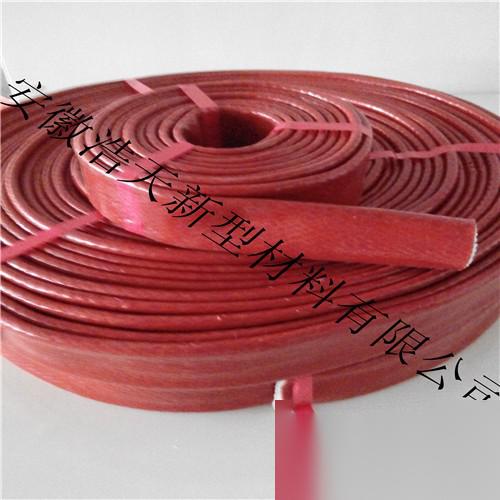Haotian Brand Hydraulic Hose Protective SleeveFeatures and Applications
1.Safe and environmentally friendly, protecting workers' health
Alkali-free glass fiber itself has strong tensile strength, is not prone to wrinkling or breaking, is resistant to vulcanization, is smokeless, halogen-free, and non-toxic, is pure oxygen non-flammable, and has good insulation properties. After curing with organic silicone rubber, its safety and environmental protection performance is further enhanced, effectively protecting workers' health and reducing the incidence of occupational diseases. Unlike asbestos products, which pose significant risks to human health and the environment.
2.Excellent high-temperature resistance
The surface of the high-temperature sleeve contains both 'organic groups' and 'inorganic structures' within its silicone structure. This unique composition and molecular structure combine the properties of organic materials with the functionality of inorganic materials. Compared to other polymer materials, its outstanding feature is high-temperature resistance. The main chain structure is based on silicon-oxygen (Si-O) bonds, where the bond energy of C-C bonds is 82.6 kcal/mol, while the bond energy of Si-O bonds in organic silicone is 121 kcal/mol, resulting in high thermal stability. Under high temperatures (or radiation exposure), the chemical bonds of the molecules do not break or decompose. Organic silicone can withstand both high and low temperatures, allowing it to be used across a wide temperature range. Both chemical and physical mechanical properties change very little with temperature variations.
3.Splash-proof, multiple protection
In the smelting industry, the medium temperature inside electric furnaces is extremely high, leading to high-temperature splashes (similarly in the electric welding industry). After cooling and solidifying, slag forms on pipes or cables, causing the rubber on the outer layer of the pipes or cables to harden and eventually become brittle and crack. This can damage unprotected equipment and cables. The high-temperature sleeve coated with multiple layers of silicone can provide multiple layers of safety protection, with a high-temperature resistance up to 1300 degrees Celsius, effectively blocking splashes of molten iron, molten copper, molten aluminum, and other high-temperature molten materials, preventing damage to surrounding cables and equipment.
4.Heat insulation, energy saving, radiation resistance
In high-temperature workshops, many pipes, valves, or equipment have very high internal temperatures. Without protective materials, it is easy to cause burns to personnel or heat loss. Haotian high-temperature sleeves have better thermal stability than other polymer materials, as well as resistance to radiation and heat insulation, preventing accidents and reducing energy consumption. They can also prevent the heat of the medium inside the pipes from being directly transferred to the surrounding environment, thus preventing excessive temperature in the workshop and saving cooling costs.
5.Moisture-proof, oil-proof, climate aging-resistant, pollution-resistant, prolonging equipment lifespan
The high-temperature sleeve has strong chemical stability, and the organic silicone does not react with oil, water, acids, and bases, remaining usable long-term without aging at temperatures below 260 degrees Celsius. Under natural conditions, its service life can reach several decades, maximizing the protection of pipes, cables, and equipment in these environments, greatly extending their service life.
6.Ozone resistance, voltage resistance, arc resistance, corona resistance
Due to the surface coating of organic silicone rubber, its main chain is –Si–O–, which makes it less prone to decomposition by ultraviolet light and ozone. The high-temperature sleeve has good electrical insulation properties, with its dielectric loss, voltage resistance, arc resistance, corona resistance, volume resistivity, and surface resistivity ranking among the best of insulating materials, and their electrical properties are minimally affected by temperature and frequency. Therefore, they are stable electrical insulation materials, widely used in the electronics and electrical industries.
7.Flame retardant, reducing fire occurrence and spread rate
If the medium transported in the pipes is flammable or toxic, a leak can easily cause fire or casualties; cables also often catch fire due to local high temperatures. The high-temperature sleeve is made of extremely heat-resistant glass fiber woven material, and the silicone rubber surface is added with appropriate flame retardants and other special materials, giving it excellent flame retardancy. Even if a fire occurs, it can prevent the spread of flames, still protecting the internal pipelines intact for a longer period, providing ample time for rescuing important data and information. 7 Commonly Used Areas:
High-temperature areas in steel, smelting, shipbuilding, chemical, and other industries; heating area cables, fluid pipelines, rolling mill cables, oil pipes, cutting edge cables, generator sets, electrical voltage equipment, large buildings, hydraulic systems, automotive wiring harnesses, and exhaust pipes, etc. 8 Testing Items and Results
High-temperature bending test
After heating for 48 hours in a constant temperature oven at 260 degrees Celsius, there was no aging, cracking, or delamination of the coating.
Low-temperature bending test
After heating for 1 hour in a constant temperature oven at -70 degrees Celsius, there was no cracking or delamination of the coating.
Coating adhesion test
No surface peeling or dissolution was observed after continuous use testing in a constant temperature oven.
Combustion test
Self-extinguishing and no spontaneous combustion (complies with UL 'VW-1' and CSA 'HFS' testing)
Temperature resistance test
( 2000hr ) 260 ℃ heating test normal without abnormalities
( 30sec ) 1200℃ heating test glass fiber intact
Flame retardancy test
Burning rate not less than 45s/25mm
---- SRG-1-7kv SRG-1-4kv,(motor insulation level can reach higher thanH levelC level)
Normal low insulation breakdown voltage 7.0 kv / min 4.0 kv / min
Normal average insulation breakdown voltage 10.0 kv / min 7.0 kv / min













